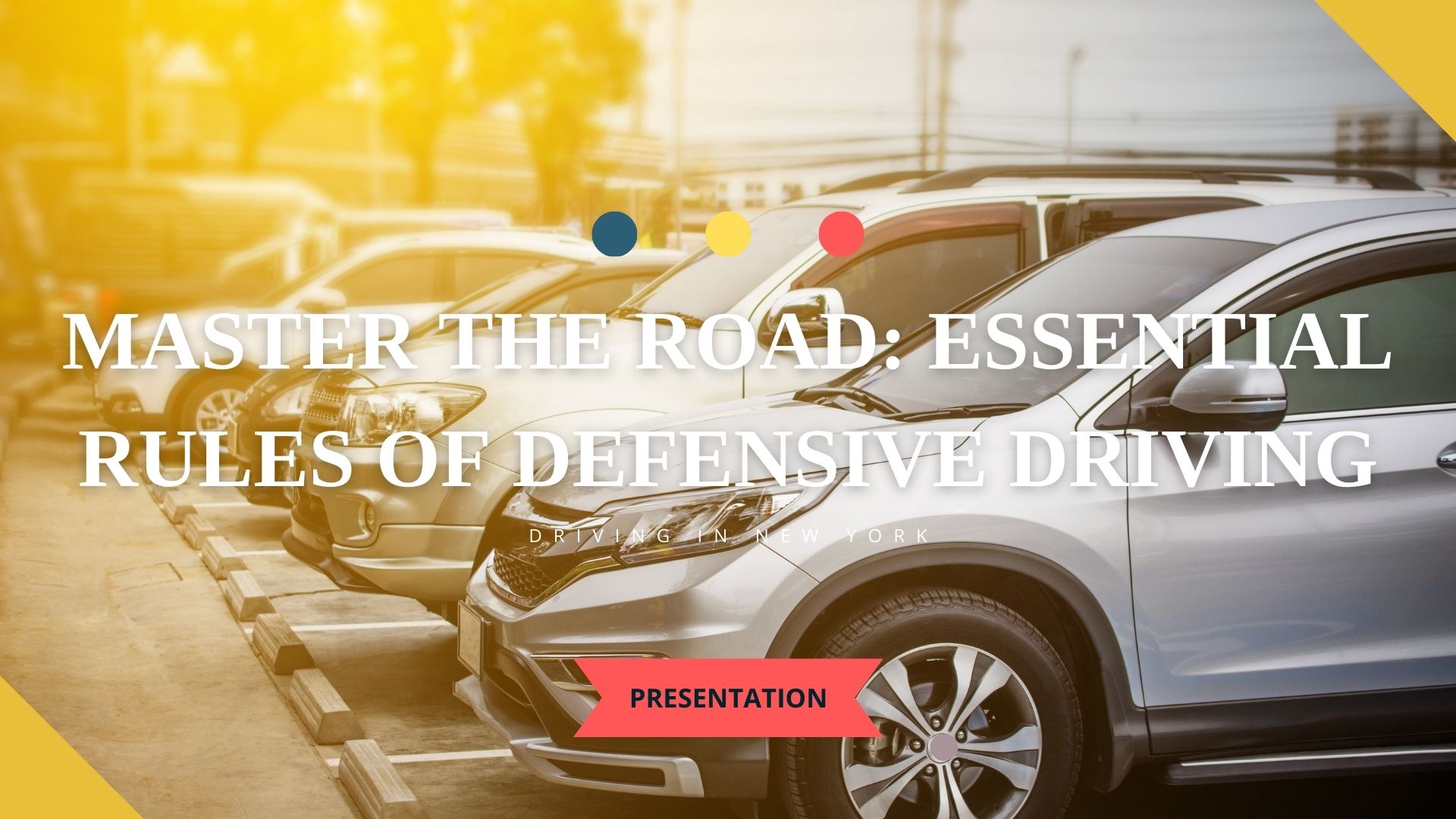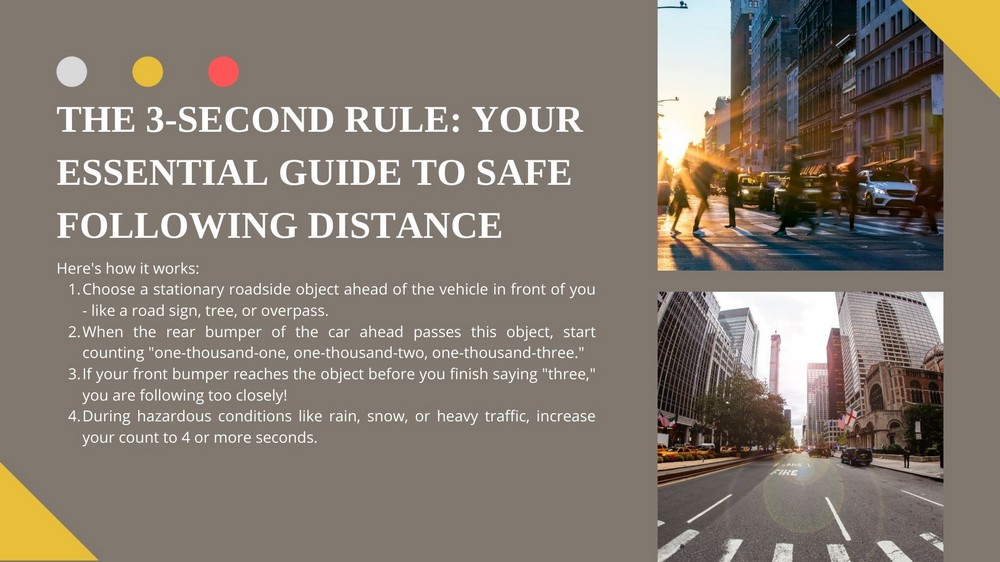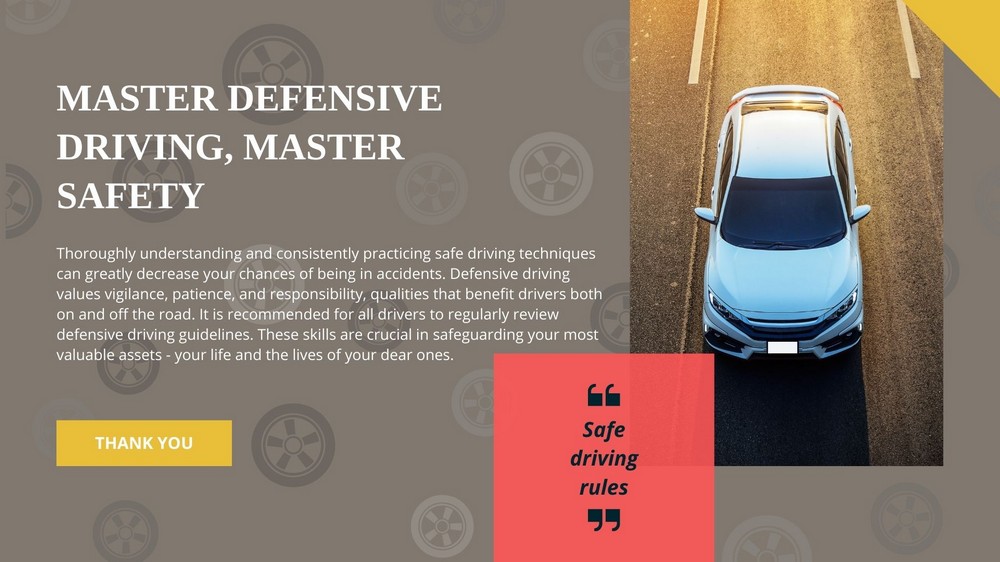Master the Road: Essential Rules of Defensive Driving

Table of Contents
We've all experienced those white-knuckle moments on the road - the close call as another driver cuts you off or the spike of adrenaline when traffic stops short right in front of you. While some amount of risk is inevitable while driving, the concept of defensive driving aims to give you the skills to anticipate hazards and avoid accidents. By learning and consistently applying defensive driving techniques, you can drastically reduce your chances of a collision.
This article will equip you with the core defensive driving rules essential for road safety. We'll start with the key principles that form the foundation of defensive driving - anticipation, observation, decision-making, and risk management. Next, we'll cover the renowned 3-second rule for maintaining a safe following distance between vehicles. Going beyond the basics, we'll also review additional defensive driving protocols like obeying traffic laws, controlling speed, minimizing distractions, adjusting to conditions, vehicle preparedness, and practicing courtesy.
Finally, we'll discuss the importance of cultivating an ongoing defensive driving mindset - one that prioritizes continuous vigilance and hazard mitigation on the road through learned skills and habits. By internalizing these rules and principles, you can drive more safely for yourself, your passengers, and others who share the road with you. So let's get started with the core concepts at the heart of defensive driving!
As mentioned, the foundation of defensive driving boils down to four key principles - anticipation, observation, decision-making, and risk management. Let's explore each of these further:
The Core Principles of Defensive Driving
Anticipation is about having the foresight to expect the unexpected. This means being aware of your surroundings, predicting potential issues, and being mentally prepared to take preventative action. For example, anticipating that the car ahead of you may brake abruptly because you notice a ball roll onto the road. Defensive driving requires paying attention to subtle cues and acting on your intuition.
Observation entails constantly scanning the entire driving environment - not just the vehicle right in front of you. You should be routinely checking your rearview and side mirrors, monitoring blind spots, and scoping out the road, shoulders, and intersections ahead of your vehicle. Catching subtle hazards early allows you to formulate and execute preventative maneuvers.
Decision-making depends on processing all the information observed while driving and using sound judgment to make safe operating choices. The decisions you make behind the wheel should prioritize hazard avoidance over expediency or convenience. This includes regulating speed appropriately, leaving ample stopping distance, and signaling lane changes well in advance.
Finally, risk management means recognizing dangerous conditions or behaviors in your surroundings and deliberately minimizing associated risks. From properly adjusting to slippery roads, avoiding impaired drivers, or disengaging from aggressive drivers - the focus here is self-preservation through intelligent precautions.
By constantly applying these four principles whenever you drive, you equip yourself with the tools to handle diverse situations and ultimately avoid collisions. Next let's go over the 3-second rule - arguably the most vital technique for managing following distance risk.
Call Us Today 6AM-10PM
Or fill out the form 24/7
Our team is here to guide you with promotions, instructor availability, and the best training package for you.
The 3-Second Rule: Your Essential Guide to Safe Following Distance

Maintaining adequate spacing between vehicles is crucial for collision avoidance and a prime example of defensive driving principles in action. The 3-second rule offers a concrete methodology for managing following distance risk.
Here's how it works:
- Choose a stationary roadside object ahead of the vehicle in front of you - like a road sign, tree, or overpass.
- When the rear bumper of the car ahead passes this object, start counting "one-thousand-one, one-thousand-two, one-thousand-three."
- If your front bumper reaches the object before you finish saying "three," you are following too closely!
- During hazardous conditions like rain, snow, or heavy traffic, increase your count to 4 or more seconds.
By preserving a buffer zone tied to your vehicle's speed, you guarantee enough time to brake smoothly or maneuver around sudden stops or debris ahead. This simple rule protects you (and the vehicle behind you) from rear-end collisions while keeping the overall traffic flow smooth. With regular practice, safe following becomes second nature.
Now that we've covered essential principles and the renowned 3-second rule, let's run through additional best practices for defensive drivers.
Beyond the Basics: Additional Rules for Defensive Driving
Mastering defensive driving requires an ongoing commitment to safety and hazard mitigation. Let's explore some key rules that need to become ingrained habits.
Obey Traffic Laws
While obvious, bearing traffic signs, signals, lanes, and speed limits in mind is essential for defensive driving. Laws and markings aim to standardize movements and behaviors to avoid chaos. Violating them introduces unpredictability and confusion for yourself and other motorists.
Mind Your Speed
Excess speed exponentially increases the severity of collisions. It also reduces reaction times to prevent collisions in the first place. Defensive drivers recognize speed limits as a ceiling, not a benchmark. Any factors impeding stability or visibility warrant decreased speed.
Minimize Distractions
Today's vehicles offer no shortage of devices and conveniences that can divert attention - cell phones, touchscreens, snacks, children, and passengers. But staying focused on driving is non-negotiable. Defensive drivers silence devices, secure objects, and refrain from activities sapping their concentration.
Adjust to Conditions
Inclement weather, construction zones, heavy traffic all require extra precautions like slowed speeds, added following distance, and heightened alertness. Defensive drivers continually adapt their driving to match the challenges at hand.
Be Prepared
Few feelings compare to the helplessness of a vehicle failure on the road. Routine inspections and maintenance greatly reduce breakdowns. Defensive drivers also check tire pressure/tread, fluid levels, lights, wipers, etc. before hitting the road.
Maintain Courtesy
Discourteous behaviors like tailgating, aggressive lane changes, and improper signaling often cascades into road rage. Defensive driving means keeping cool under frustration and setting a positive example through safe - and considerate - operating habits.
Now let's tie everything together into an all-encompassing defensive driving mentality.
Putting It All Together: Cultivating a Defensive Driving Mindset
We've covered the key principles, vital rules, and driving best practices fundamental to defensive driving. But knowledge alone cannot keep you safe. You need to ingrain these teachings into your mental framework on the road at all times.
Defensive driving requires a deliberate, vigilant mindset centered on hazard anticipation and prevention. You must tune into your surroundings, fight complacency, suppress distractions, and invest yourself wholly in the mission of safety. Core principles like anticipation, observation, decision-making, and risk management need to guide your every move.
Make behaviors like checking mirrors and blind spots, maintaining a safe distance, scanning ahead, and adjusting speed routine and subconscious. Choose precaution over right-of-way, patience over pressure, and focus over expediency each time you operate a vehicle. Commit to mastering one new defensive rule at a time until driving safely becomes second nature.
Your vehicle weighs tons and moves at high velocity - treat it with respect. Adopting a defensive driving mentality means embracing the immense privilege and responsibility that comes with driving. By internalizing the techniques covered throughout this piece, you can develop the skills to handle diverse conditions and, above all, protect lives.
Call Us Today 6AM-10PM
Or fill out the form 24/7
Our team is here to guide you with promotions, instructor availability, and the best training package for you.
Master Defensive Driving, Master Safety

In this article, we've explored the essential rules and principles for defensive driving - a strategic approach to hazard anticipation and collision avoidance behind the wheel. We discussed four core concepts - anticipation, observation, decision-making, and risk management - that provide a foundation for safe operating habits.
We also covered the well-known 3-second rule for maintaining safe following distance between vehicles as well as additional protocols like obeying traffic laws, controlling speed, minimizing distractions, adjusting to conditions, vehicle preparedness, and practicing courtesy.
Finally, we emphasized the importance of cultivating an ongoing defensive driving mindset characterized by alertness, evaluation of hazards and risks, and continuous proactive decision-making.
By thoroughly learning and consistently applying these safe driving practices, you can significantly reduce your risk of accidents. Defensive driving rewards vigilance, patience, and responsibility - qualities that serve drivers well on and off the road. We encourage all motorists to regularly refresh their knowledge of defensive driving rules. After all, the skills learned ultimately protect your most precious cargo - your life and the lives of your loved ones.
Call Us Today 6AM-10PM
Or fill out the form 24/7
Our team is here to guide you with promotions, instructor availability, and the best training package for you.
Frequently Asked Questions
-
What is defensive driving?
Defensive driving refers to driving strategically to anticipate potential hazards, avoid accidents, and minimize risk. It involves techniques like scanning ahead, maintaining safe following distance, adjusting to conditions, and avoiding distractions.
-
What are some key rules I should follow?
Important rules include obeying traffic laws, controlling speed, allowing adequate stopping distance per the 3-second rule, eliminating distractions, properly maintaining your vehicle, wearing seatbelts, and adapting to conditions like bad weather.
-
How can defensive driving help me?
Defensive driving makes you an empowered driver who helps prevent accidents. It lowers your chance of receiving traffic citations. Many insurers offer discounted premiums for completing defensive driving courses. Most importantly, it protects you, passengers, pedestrians, and other motorists.
-
Why should I scan ahead while driving?
Scanning at least 10-20 seconds ahead allows you to identify risks early, such as debris on the road or sudden slowing vehicles so you can brake more gradually or change lanes. Scanning ahead, checking mirrors, and watching blind spots provides complete situation awareness.
-
What contributes to distracted driving?
Texting, phone calls, programming navigation devices, eating, adjusting music or climate controls, attending to children - anything sapping attention from driving can be classified as a dangerous distraction.
-
How can I deal with aggressive drivers?
Do not respond or retaliate, as this frequently escalates hostile behaviors. Slow down to give space, change lanes if possible or consider pulling over. Never stop or exit your vehicle in response to an aggressive driver. Report serious or ongoing incidents to law enforcement.
I hope these answers provide clarity on important defensive driving topics. Let me know if you have any other questions!
 English
English Spanish
Spanish 

